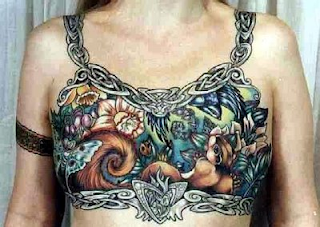Angel or Succubus?
This woman’s tattoo represents purity and honesty,
but what does it really make you think of her?
(Angel, n.d.)
“Never judge a book by its cover”, “Things aren’t always what they seem”, “Appearances can be deceiving,” these are all phrases that most mothers have told their children at some point; mine said them to me quite regularly. In an ideal world none of us judge each other based on appearance, and first impressions are passing and easily reversed. The sad reality is that we do judge each other based on what we see, and create associations based on opinion. Consequently, we create a first impression before the person we are interacting with has a chance to act.
My tattoos cause me a lot of problems with men. Virtually every day at work, school, even at the park with my daughter I deal with lascivious looks and comments. I do not dress in a provocative nature, maybe a little unconventional, but my crazy goth/punk rock days are far behind me. I have become expert at deflecting and ignoring unwelcome advances. Here’s how it plays out:
Rachel. Stocking shelves at Trader Joe’s. Male stranger approaches.
Stranger: Excuse me, where are the dark chocolate covered raspberry wafer cakes?
Rachel turns. Stranger steps in closer.
Rachel: Right over here, sir. I will walk you to them.
Rachel walks Stranger to product, and hands product to Stranger.
Stranger: Thank you. Nice tatts. How many do you have?
Stranger touches Rachel’s arm, stroking a tattoo. Rachel steps back.
Rachel: Thank you, I have several. Excuse me, I am needed at the register.
Rachel quickly walks away.
This scene or a variation thereof, occurs every day. Firstly, let me make something clear. People with tattoos do not say, “Nice tatts.” As a rule we do not even use the word “tatts.” It is considered somewhat garish, and uncouth. “Nice tatts” is generally used by people without tattoos to start a conversation with a tattooed person. This is fine, unless you are using it as a conversation starter to hit on a married woman.
It is obvious that strangers are making assumptions about what I find acceptable based on my appearance. But, what are they assuming? Some (too many in my opinion) find it suitable to touch me, frequently without even talking to me first. I wear a wedding ring, yet they persist even after I bring my hand to my face where they can no doubt see it. What lies are my tattoos telling people?
Controlled studies show that tattoos affect people’s opinions of one another. Tattooed persons are perceived as engaging in more risky and promiscuous behavior than non-tattooed persons. Tattoos create a perception of an association with certain subcultures and rebellious behavior. Tattooed persons are viewed as less inhibited, and as voracious seekers of excitement and pleasure. Tattoos are commonly associated with uninhibited sexual behavior and undesirable characteristics (Wohlrab, et. al., 2009).
So, my tattoos are triggering these associations and thus influencing people’s behavior towards me. It is assumed that I do not adhere to social norms and may be sexually promiscuous, therefore it is acceptable to touch me in an intimate fashion uninvited. Tattoos are also associated will lower intelligence in (Wohlrab, et. al., 2009). Thankfully I have been able to combat this assumption by being well spoken and polite.
To a certain extent the behaviors associated with tattoos are accurate, though not universal. I, and most of my tattooed friends, do seek out new experiences and “risky” activities; we are “sensation seekers” (Wohlrab, et. al., 2009). We are, most of us, however in long term, monogamous relationships. I have known many people who engage in risky sexual practices, and have multiple partners; though I can’t say that a disproportionate amount of them were tattooed.
Tattoos do act as indicators of certain things about people, but only if you are educated about tattooing in general. A few things I have been able to tell about a person based on their tattoos are: if they have been in prison, their theological beliefs, if they are from the East coast or West, what subculture they identify with, and what kind of music they like. Unless a person has a tattoo of a very specific nature their tattoos will not tell you: their sexual preferences or habits, nor if the frequently engage in risky and undesirable activities.
It is always important to remember that tattoos tell a story of a person’s past. Even if a person’s tattoos tell me they have been incarcerated, I make no assumptions about who they are now. To truly know a person, you should let their action speak for them, not their outward appearance. My mom taught me that, and I try to live by it every day.
Wohlrab,S., et. al. (2009). Differences in personality attributions toward tattooed and nontattooed virtual human characters. Journal of Individual Differences, Retrieved September 13, 2011. PsychARTICLES.









